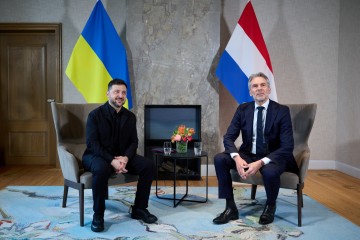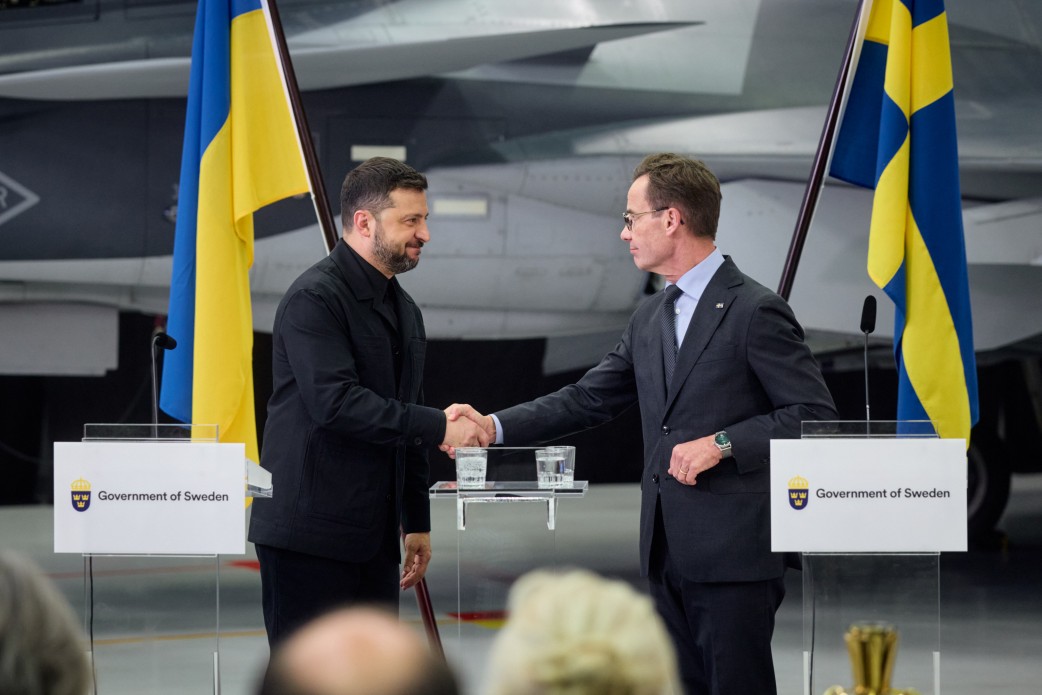In October, President of Ukraine Volodymyr Zelenskyy held more than 40 meetings with national leaders, heads of international organizations, government officials, and representatives of partner teams; he also made around 20 phone calls, and participated in six forums, summits, and leader-level sessions.
The Head of State’s priorities included ending the war, further defense support, increased funding for drone production, development of joint defense manufacturing, expanding the number of partner countries participating in the PURL initiative, and the effective, mutually beneficial use of the SAFE financial instrument.
Key topics of discussion also included Ukraine’s air defense, particularly accelerating the delivery of relevant European and American systems and compatible missiles. This matter was discussed with leaders of the United States, Germany, the Netherlands, Spain, Italy, the United Kingdom, and France. Ukraine expects tangible results in strengthening air defense in the near future. Additionally, agreements were reached with the Czech Republic and Poland to enhance the protection of Ukraine’s airspace and air fleet.

Consistent attention was given to increasing pressure on Russia, including through sanctions, identifying opportunities to use frozen Russian assets for the defense and reconstruction of Ukraine, and advancing EU membership negotiations.
A particular focus in October was support for Ukraine’s energy sector ahead of winter, as the country’s energy system continues to face constant attacks from the Russian Federation.
Last month, the President undertook working visits to Denmark (for the 7th European Political Community Summit), the United States, Norway, Sweden, Brussels (for the European Council meeting), and the United Kingdom (for the Coalition of the Willing leaders’ meeting).

One of the main outcomes was a new and largest-ever agreement for Ukraine’s combat aviation. On October 22 in Linköping, Sweden, President Volodymyr Zelenskyy and Prime Minister of Sweden Ulf Kristersson signed the first document paving the way for Ukraine to receive Gripen aircraft – the Letter of Intent Between Ukraine and the Kingdom of Sweden Concerning Cooperation in the Field of Air Capabilities. Our country anticipates receiving up to 150 of these fighter jets, with the first arriving next year. The leaders also met with the leadership of aircraft manufacturer Saab AB, discussed all cooperation prospects, and had the opportunity to personally observe the capabilities of the Gripens.
“These are great aircraft, strong aviation platforms capable of performing a wide range of missions. Everyone can see what threats they help counter. Russian strikes against our state – they do not stop,” emphasized Volodymyr Zelenskyy.

During his visit to Washington on October 17, President of Ukraine Volodymyr Zelenskyy met with U.S. President Donald Trump. Key topics included the battlefield situation, energy cooperation, diplomatic prospects for ending the war, strengthening Ukraine’s air defense, and long-range capabilities.
“Over two hours of a pointed conversation with President Donald J. Trump that can really help bring this war closer to an end. We discussed all key issues. Russia must end the aggression it started and continues to deliberately prolong. We count on the United States’ pressure,” the Head of State wrote on social media following the White House meeting.
After the meeting, the President also held a joint phone call with leaders of the United Kingdom, Germany, Italy, Finland, Norway, and Poland, as well as the Presidents of the European Commission and the European Council, and the NATO Secretary General.
Additionally, Volodymyr Zelenskyy discussed Ukraine’s need for Patriot systems and compatible missiles, and F-16 aircraft, with representatives from Lockheed Martin and Raytheon. Together with the Secretary of the U.S. Department of Energy, Chris Wright, and energy company representatives, he discussed cooperation in energy projects. The United States assured assistance to strengthen Ukraine’s energy resilience amid constant attacks by the Russian Federation. A meeting was also held with the heads of American think tanks.
During the meeting held in Norway on October 22, Prime Minister Jonas Gahr Støre announced the third energy aid package for Ukraine this year, of approximately USD 150 million for winter gas procurement. This brought the total support to USD 400 million.

On October 23, the Head of State participated in a European Council session in Brussels. Volodymyr Zelenskyy also conducted seven bilateral meetings with partners, including the President of France, the Prime Ministers of Poland, Finland, and the Czech Republic, the Federal Chancellor of Germany, the President of the Council of Ministers of Italy, and the President of the European Council. Discussions focused on further defense support, including through PURL and SAFE mechanisms, air defense enhancement, energy support, and the prospect of using frozen Russian assets for Ukraine’s needs.
Following the European Council session, the European Union confirmed that financial aid for Ukraine will continue in 2026–2027.
“Europe is politically ready to channel frozen Russian assets into comprehensive support for Ukraine and Ukrainians. The European Council reached a political decision – the clear framework for using the assets, and this framework has been defined. We now also agreed in Europe that this framework must be implemented by the end of the year,” said the President of Ukraine.
During his visit to the United Kingdom on October 24, the Head of State met with King Charles III and Prime Minister Keir Starmer. Discussions with the Prime Minister focused on developing joint defense production, particularly Octopus interceptor drones. The United Kingdom will manufacture these drones for further testing in Ukraine, with the potential for scaling up production.

In London, the Coalition of the Willing convened with over 40 participants from various countries. Discussions covered air defense, energy, sanctions, and long-range capabilities. The Head of State called for accelerating the finalization of future security guarantees frameworks. Outcomes included more sanctions against Russia, with agreed measures, and an increase in effective long-range Ukrainian sanctions.
“The questions about Tomahawks, about Storm Shadows, SCALPs, about our joint production of drones and rockets – these are vital. And as soon as Putin felt pressure and the possibility of Tomahawks appearing in Ukraine – he immediately declared his readiness to restart talks, but as soon as the pressure disappeared, he abandoned diplomacy again,” emphasized Volodymyr Zelenskyy.
At the sidelines of the European Political Community Summit in Copenhagen earlier in the month, the Head of State held over 10 meetings with partners, including the Presidents of Azerbaijan, Cyprus, Moldova, and France; Prime Ministers of Denmark, Norway, Poland, Portugal, and Sweden; Germany’s Federal Chancellor; Italy’s President of the Council of Ministers; and the Presidents of the European Council and European Commission, and NATO Secretary General.
In October, Volodymyr Zelenskyy held about 20 phone conversations with the Presidents of the United States (two calls), Finland (three calls), France (two calls), the Czech Republic, Argentina, the Democratic Republic of Congo, as well as with the Prime Ministers of the United Kingdom, Germany, Denmark, Canada, Greece, and Spain; Germany’s Federal Chancellor; the President of the European Central Bank; and the leader of the party that won the parliamentary elections in the Czech Republic.
Topics included coordination of diplomatic steps, expanded defense cooperation, particularly PURL initiative development, air defense enhancement, support for Ukrainian energy, and increased sanctions pressure on Russia.

Furthermore, in October, the President held more than 10 meetings with partners visiting Ukraine, including the Prime Ministers of the Netherlands and Lithuania, the High Representative of the European Union for Foreign Affairs and Security Policy, the OSCE Parliamentary Assembly President, the Speaker of the Lithuanian Seimas, and Ministers from Denmark, Estonia, the Netherlands, Slovenia, and Croatia.
These visits focused on defense support and joint weapons production, implementation of PURL and SAFE mechanisms, and energy assistance to Ukraine. In particular, on October 11, during the visit of the Minister of Defense of the Netherlands, the Memorandum of Understanding concerning the Coproduction of Drones was signed.
In October, the Head of State delivered online addresses to the European Council at the beginning of the month and the 71st Annual NATO Parliamentary Assembly session. The President also participated in the third International Defense Industries Forum in Kyiv and met with leaders of international and Ukrainian investment funds and business associations attending the event.
“Our production potential for drones and missiles alone will reach USD 35 billion next year. Despite strikes, despite the objective difficulty of the very task of building a defense industry – and weapons are technologically complex, hard to design, manufacture, and field – despite all the difficulties, Ukrainians are creating their national defense product that, in certain parameters, already surpasses many others in the world,” emphasized Volodymyr Zelenskyy.
Among other achievements last month, a significant result was the expansion of the PURL initiative. In October, Spain, Finland, and Slovenia joined the program, and Norway announced its second contribution. This brought the total number of participants to 16, with declared contributions reaching USD 2.6 billion.

Sanctions pressure on the Russian Federation is intensifying. Ukraine adopted six decisions to introduce or extend expiring sanctions, targeting Russian entrepreneurs and their ties to Putin’s system, the Russian military-industrial sector, and individuals and companies linked to the Russian oil sector. Also, Japan’s sanctions were synchronized within our country’s jurisdiction. Overall, 11 packages of partner sanctions have been aligned in Ukraine’s jurisdiction since the beginning of the year.
The approved 19th EU sanctions package includes restrictions on Russia’s shadow oil fleet, banking and financial systems, and a ban on LNG imports. For the first time, sanctions were imposed on crypto platforms and cryptocurrency schemes.
U.S. sanctions against Russia’s two largest oil companies, Rosneft and Lukoil, approved in October, are particularly significant. In the same month, the United Kingdom expanded its sanctions list against Russia, including Rosneft, Lukoil, over 50 vessels linked to the shadow fleet, several banks, four oil terminals, and imposed a ban on importing oil products made in third countries from Russian crude. UK sanctions froze Russian assets worth GBP 28.7 billion.
In the near future, Ukraine will synchronize the 19th EU sanctions package and U.S. sanctions against Rosneft and Lukoil within its jurisdiction.
Our country is already preparing new sanctions measures for November and expresses gratitude to all partners who continue working to increase pressure on the Russian Federation, in particular against its shadow fleet. The formation of the European Union’s 20th sanctions package has begun, and Ukraine has submitted its proposals. We also expect to work together with the United States to minimize Russian energy exports as much as possible.
To support Ukraine’s energy sector, which is especially critical now, agreements have been reached not only with Norway but also with Germany, Italy, the Netherlands, and the European Union. Thanks to the support of our partners, 70 % of the funds required to purchase gas for the winter have already been secured.




